Dennison Ramalho Talks to Offscreen at Fantasia 2018
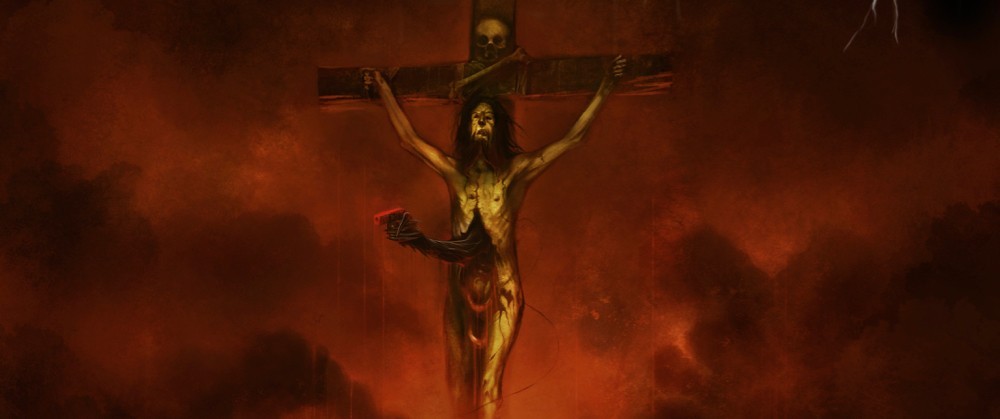
In 2003, the bar for Fantasia’s Small Gauge Trauma short program was raised to a new level, arguably still in place over 15 years later. The film was Dennison Ramalho’s Love from Mother Only, the second short from this Brazilian filmmaker steeped in the very particular religious and cultural tensions that infuse his homeland. Now, several shorts, scripts, and a first feature later, he still regards Love from Mother Only as his best work, an uncommonly specific invocation of Macumba, so committed to its presentation of possession and spell casting that its most supernatural elements feel the most real. But this is not to say he hasn’t progressed as a filmmaker. You can feel Ramalho’s “special participation” in José Mojica Marins’ Embodiment of Evil, both a return to the beloved character of Coffin Joe from the 1960s and a harrowing portrait of urban Sao Paolo, Ramalho’s script (and assistant direction) highlighting the clash of textured street realism and outlandish occultism that made that film as solid an entry as it is. While we all hoped for a feature of his own to follow soon after, Ramalho returned with another short film two years later, Ninjas, equally uncompromising as Love from Mother Only. The new short felt very much a natural extension from his work with Marins but now stripped of any of the popular affection for Coffin Joe that provided an accessible inroad to that film, instead dropping us right in the heart of brutal police corruption and its connection to the increasingly Evangelical religious orientation in Brazilian politics. Finally, 20 years after the release of his first short, Nocturno (rejected from the 1998 edition of Fantasia before the festival fell forever in love with the rest of Ramalho’s work), we now have a full-fledged Ramalho feature, The Nightshifter, which finds the director bringing the no-holds-barred aesthetic that ran free in his shorts up against the demands of narrative, which, as we’ll learn, included specific requirements from the production company footing the bill in the context of the Brazilian audience. The Nightshifter played to high praise at Fantasia and after a successful run on the festival circuit has now been picked up by Shudder, the horror streaming channel. It’s a testament to Ramalho’s development as a filmmaker that his first feature can attract international distribution after delivering extremely difficult work in his earlier efforts. One can only hope that the success of The Nightshifter will have a positive retroactive effect on these earlier shorts so that more of the world can behold their savagery in all its glory. Offscreen editor-in-chief Donato Totaro and I sat down with Ramalho after his screening of The Nightshifter at Fantasia 2018 to discuss his most recent film, why it has taken so long to realize, and how it connects back through his body of work and the line of Brazilian cultural specificity that runs throughout. [-Randolph Jordan]
Developing The Nightshifter
Donato Totaro: How difficult was it for you to wait between your last short film to your first feature? What were you doing in between?
Dennison Ramalho: Right around the same time that I did Ninjas, in 2010, I applied for a Fullbright Scholarship to go to graduate school in New York. So I did get the scholarship, I got married, and me and my wife relocated to New York and for four years I was in the film graduate program at Columbia University. So yeah, I was studying film. I really wanted to get a proper education. Film schools in Brazil are not the best film schools in the world and I got this chance with my history and my portfolio of shorts and scripts so I spent these years studying film.
D.T. We both love the intensity of your last two short films, Love from Mother Only and Ninjas. I don’t think I’ve seen your first film, Nocturno.
D.R. Nocturno, a vampire film which I shot on 16mm in black and white, was not selected for Fantasia. I never really talked to Mitch [Davis] about it. It played other festivals but not Fantasia. But I remember when I submitted Love from Mother Only, I’ll never forget Mitch’s email with the subject line, “What the fuck was that?” And that was Mitch telling me “we want the film.”
D.T. So in a short film you don’t care as much about character development etc. With only 20 minutes you can be very intense right from the beginning to the end. So in your feature we found it was much more dependent on character and narrative and twists. So as a filmmaker going from shorts to features, how did you think about this transition?
D.R. I had previous experience putting together a feature with Embodiment of Evil, which wasn’t my film but was my brainchild with Mojica, and I followed the whole montage and post-production of the film and the thoughts behind the pacing of that film so I learned a great deal about that there. And also I do a lot of writing, it’s what basically pays my bills way more than directing, and I’m doing a lot of series writing in Brazil for the Global Network. So writing for longer formats has taught me a lot about pacing.
Randolph Jordan: Have you ever thought about trying to make a feature that dispenses with narrative requirements and attempts to maintain the same intensity as your shorts through the duration of a longer running time? More of an atmosphere and less a story?
D.R. Maybe because of all of these years studying drama I have become very much in love with character development, arcs, change, so all of the projects I envision for the near future are way more character driven. But still, atmosphere is very important for me so I really want both things to go hand in hand. I don’t see myself doing something very experimental. I’ve become very much a drama driven filmmaker. In the short films, finding my voice as a filmmaker, I was more concerned with atmosphere over character, but these days I think these things go hand in hand. And it’s there in The Nightshifter.
R.J. I’m just curious, did you see Luz at the festival this year?
D.R. Yes I saw Luz. I was totally blown away. It goes in the direction that you’re describing. It’s way more experimental, but still it has some drama in it. I’m always looking for that balance. I think it’s really important not to be conventional or predictable, to experiment, and I think Luz found a good balance for it. I think The Nightshifter is more conventional compared to Luz, but that was the nature of the project because it was a commission [see details below]. But for my next project I plan to go visually experimental but still very much tied to character development.
R.J. You mentioned in the Q&A that The Nightshifter is going to act as the pilot for a TV series in Brazil. Is that officially happening?
D.R. No, it’s not officially happening. When I was still at Columbia I had to go back to Brazil because the rules of the scholarship said that I had to work in the Brazilian industry for the same number of years that I held the scholarship in order to pay it back. So I was about to move back to Brazil when I was contacted by a production company, Casa de Cinema de Porto Alegre. This company was very important for me in my early years because they are based in my hometown, in Porto Alegre in the south of Brazil. That’s the city where Fantaspoa festival has been happening for the last 10 years now. And when I started my career as a filmmaker I would work as a PA for commercial companies but Casa was a production company dedicated to fiction only. All their features and short films were made to be presented in the cinema. They didn’t do much television at the time – nowadays they do, and they won an Emmy two years ago for a comedy series that they did in Brazil. So I was a product of Casa de Cinema since it was like my first house working in film. After that I moved to Sao Paolo after making my first short film and worked for several companies there. But after so many years [Casa] contacted me and said they have this channel called Space, a cable channel, part of a corporate group. They wanted to make a horror series and they’re looking for projects here in Brazil and wanted to know if I had something that I could pitch to them. I said that I didn’t have anything at the moment but could come up with something based on the short story written by a friend of mine, a horror writer, so they said okay, let’s see if we can come up with something. So I contacted Marco [de Castro], writer of the short story for Ninjas, and he had this other story that I liked a lot, Morto Nao Fala [The Dead Don’t Speak], about a morgue attendant who talked to the dead and Marco said of course, it would be great if we could come up with something. So he gave me the permission and I wrote the pilot for a 30-minute episode. They submitted it to Space channel and they took forever to reply to us.
And in the meantime George Furtado, a very celebrated Brazilian filmmaker – I don’t know if you ever heard of a short film called Isle of Flowers, a very important piece of Brazilian filmmaking, a documentary about a place, this little island in a lake next to Porto Alegre, and the city dump is there. So on this island there are miserable homeless people living around the city dump, and there are also people who raise pigs to sell the meat. There was a rule that the pig farmers had the right to feed the pigs with whatever they could find in the dump, and only after the pigs were fed were the homeless people allowed to eat. So George Fortado had worked a long time for the Global Network, the biggest Brazilian syndicated TV network since the 60s, huge in Brazil and also internationally, in all Portuguese language territories. Big in the telenovella world. So they’re now coming up with series’ that they want to bring to the international market in order to compete with Netflix and AMC level series on an international level. So they boosted the quality of their programming by hiring seasoned film writers and directors. So Fortado is involved in a number of these projects for Global and one day in a meeting the head of series production said they should try their hand at horror, so Fortado said that they had a project stuck at Space channel. Head of production read it and said that they wanted it right now. So I moved back to Brazil, already hired by Global Network, and over a year and a half they gave me an office and paired me up with another writer, Claudia Juvon, based in Rio. Juvon is a filmmaker in her own right, she directed a feature film, like a sci-fi comedy about two years ago, and a total horror fan who always wanted to do something in horror, so for a year and a half we wrote the first version of a series, eleven episodes of 60 minutes.
When Global read it they were taken aback. “Okay, it’s horror, we get it, we’ve seen your short films, but this is too dark for us.” They were afraid that they would only be able to play it very late at night. But they wanted something. So a rule fell into place: a 15 year-old should be able to watch the series and take interest it. So I could go as dark as I want within that range. So basically they wanted me to do a PG-13 series. So Global said they still love the project and the character, so let’s make a feature film and find a distributor to run it theatrically, we’ll send it to festivals, we’ll make the best film we can, effects-wise, quality-wise, and if it goes well we’ll resume the series project. So it’s not guaranteed that it’s going to happen, but that’s the story of the series thus far. The The Nightshifter film ended up being not quite like that, young adults would appreciate it more than teenagers. But we’ll see what happens. And that’s why the ending of the film is kind of open: he goes into exile, away from his family and followed by the dead people that he betrayed. So in the revamped series he becomes this wandering character who atones for his mistakes, correcting his wrongdoing by using his powers to help people, while getting into dangerous situations and dealing with misfortunes along the way.
R.J. So if this was developed for TV then would it have to be toned down compared to the film? Or is the film in line with the tone Global wants for the series?
D.R. No the film was made according to Global’s demands as a test for reaching out to younger audiences. They told me I could not make an NC-17 or even R-rated kind of film. I think in the U.S. we will get an R rating, but I got away with the sexual material with Global.
D.T. But at least you didn’t have to design the film around characters of the same age as the target demographic. You don’t have any 15 year-old characters in the film to help sell the film to that market. Teenagers will have to project a bit to understand the adult themes in the film.
D.R. Yeah I think we were aiming more towards young adults, we managed to push it up a bit. I think a decisive moment in Global’s decision to move into horror content was Walking Dead. It got huge ratings in Brazil so they wanted to get into that kind of thing. Teenagers loved Walking Dead so we were able draw on that precedent in setting our tone. I don’t know if the series might have to be toned down even further. We’ll see.
D.T. So you’re doing the Talking Dead.
[laughs all around]
Brazilian Audiences and Religion
R.J. So is there anything different that you notice in the Brazilian context with regards to tolerance for sex and violence as compared to North America or other markets?
D.R. Yeah I have a lot to say about that. First, this isn’t an indie production. There’s a big company behind it so even if the series doesn’t happen the film will get played theatrically and put into Global’s streaming platform, etc. But Brazilian audiences are VERY conservative. If we were doing cable, that would be fine to show more sex, more violence, but it really causes reactions, frissons. I remember there was this famous case about four years ago, for the first time in Brazilian televised dramaturgy a telenovella showed a gay couple kissing. And this was huge. In the press, all over the country, nobody talked about anything else. The gay kiss. There was a lot of resistance. A lot of people protested, “how can you show this to our youth?” So Global is crawling their way forward as best as they can. They think progressively, but still they are afraid to lose audiences, so it’s always a complicated negotiation. So they are very afraid to show violence. Extreme violence is unheard of. I would say that some of what happens in The Nightshifter could be categorized as extreme violence, so this is the first time they’ll be showing stuff like that and I don’t know what the reaction will be like. As far as the series is concerned, if it happens they want it to be progressive. They want to allow me to show more in order to compete with international series’. But still they have this problem, the Brazilian public.
R.J. Is that because of Catholicism?
D.R. As a matter of fact, I miss Catholicism. Brazil, unfortunately, is no longer a Catholic country. Evangelical religions, especially neo-Pentecostal, have grown exponentially over the last 20 years, so Brazil is now an Evangelical country. Which is worse than a Catholic country. The Catholics were so institutionalized, a whole generation of sons and daughters of Catholic people were relating to religion in a more progressive way, not always relating to the old ways. When Brazil converted to Evangelicals, that’s when the shit really hit the fan. If the Catholics were conservatives, the Evangelicals are ultra-conservative. We are living now a horrid cultural moment in Brazil.
D.T. The victory of José Marins! He succeeded in banishing Catholicism from Brazil! But he didn’t realize it would be replaced by something worse. [laughs]
R.J. The Catholics at least appreciate art and gore. Some of those medieval crucifixion scenes remind me of Ninjas.
D.R. There is very bad shit happening now in Brazil where provocative content is concerned. Many of the politicians in Brazil are Evangelicals. Some of them are pastors. You know, these media evangelists got elected by their faithful flock, and we’re talking millions of peoples here. So they’re proposing laws that are being discussed right now in the Brazilian congress, and some of them are ascending to the Senate. For example, like prohibiting the presentation of Black Metal bands in Brazil. Anything offensive. But since Brazil is supposed to be a secular country, so they say that anything that is offensive to any religion should be banned in Brazil. So heavy metal bands that use iconoclastic imagery should not be allowed in the country to perform. But it’s these Evangelicals who are proposing the laws, advocating their own cause under the umbrella of religious equality. The band Ghost, for example.
Ghost B.C. performing “Secular Haze”
Ghost performed at this major festival in Brazil to much scandal and made the news. After this performance an Evangelical politician proposed this new law. I hope in my heart that it never passes. So we’re living a very delicate cultural moment in Brazil and Global Network has to deal with that as the major mainstream TV network in the country with a huge portion of its audience newly Evangelical.
D.T. So in terms of the toning down of content in this context, it seems to me that politics would also be a sensitive issue. Like Ninjas is your most political film, so critical of corruption in authority.
D.R. The Brazilian TV networks would never get into something that extreme and that provocative. But it did play in Brazil, and was in competition in some of the most important film festivals in the country.
R.J. This might be a good time to ask about the themes in your films, a balance between the politics, the gangster stuff, and the religious elements, both Christian and the Macumba. Where does that sit now in the context you’ve described? It must be even more sensitive to talk about political corruption and street realities in the context of religion, as you do.
D.R. Religion is always a complicated issue in Brazil. I personally loathe any organized religion. This results, in part, from my background. I was raised in an Evangelical family. I don’t identify with the thinking in organized religion. I always wanted to make films that would speak of Brazil in a thought-provoking manner. Nowadays it’s more complicated to touch these subjects. And especially when you talk about Macumba, the African-Brazilian religions, because the Evangelical groups have grown so big in Brazil and there is this media persecution by the Evangelicals of the African religions. So when I show African-Brazilian witchcraft in Love from Mother Only, we’re talking about a very, very small group, or cult, within the bigger African-Brazilian religious realm, which is composed of very benevolent religions who only invoke very benevolent spirits in their midst, they do not perform any animal sacrifice anymore, they abolished that, now they offer flowers and fruit, plants, to their entities. But to the Evangelicals, ALL African-Brazilian religions are like Satanism. So they tarnish the group as a whole in every way possible through their channels, their shows on syndicated television etc. One of the biggest stations in Brazil was bought by one of the big Evangelical churches, and they use it as a platform for tarnishing the African-Brazilian religions. So it would be very difficult for me to make a film like Love from Mother Only today, 15 years later. Because if I tried to secure public funds for it, I think nowadays the jurors would say, “should we really give it to this guy? Because that might get us in trouble with this congressman, or at the Sao Paolo prefecture.” Yeah it’s more difficult today. But still, my next feature film project delves exactly into that universe. It’s like Love from Mother Only made into a feature. Let’s see what I can get out with.
D.T. Love from Mother Only is your only film that isn’t really urban, set instead in this more rural, coastal environment. It creates a completely different feel.
D.R. I wanted it to be timeless. I didn’t want to set it in a certain place and time. We don’t know if it’s happening today, or fifty years ago, in this very rustic, secluded environment. I think the film is impressive for how fresh the film is. Someone posted it on YouTube and the view count is always growing, always recent comments in the comments section. I’m so happy that it still has this life. I still think it’s my most beloved film, my best piece of work.
D.T. Do you still have the 35mm print?
D.R. Yeah, the negative is deposited at the Brazilian cinematheque.
D.T. Have you done an HD scan of it?
D.R. No.
R.J. So far I think it’s only been released on the Small Gauge Trauma DVD that Fantasia and Synapse put out a while ago.
D.R. That’s definitely the best video transfer to date. And Ninjas already exists in 2K, since we needed a good master to make festival copies for those who can’t run 35mm projections. [There may be progress on a new scan and wider release of Love From Mother Only. Stay tuned… -ed.]
D.T. And in Ninjas it feels like a serious political statement when it’s Christ giving him the gun in the film.
D.R. Exactly. The scariest thing about Ninjas, for me, comes from an incident a few years back in Brazil. There was an anonymous inhabitant of a favela [low income shantytown on the outskirts of Brazilian cities], secretly taking VHS footage of a troop of police officers on patrol, and every night they stayed at the same place and pulled over cars, beating and shooting people, or shooting at people to scare them, terrorizing them, and the tape was sent to the government, creating a scandal. So they went and found out who the cops were, showed them on national television. Out of seven cops, five of them were church-going Evangelicals. So I thought, wow, these guys are doing this and believing that it is doing God’s work, cleansing society from crime. There’s this violent shock unit in Rio de Janeiro, they made a movie about it, an elite squad, and most of these guys are Evangelicals. They enter favelas in extermination mode.
D.T. I wonder if this is influencing the Philippines where they have policies in place now where you can kill drug addicts and not be indicted.
D.R. Yeah, Brazil hasn’t gotten that bad yet. But it’s bad enough. The police force is basically thinking like that already. It’s dangerous enough if they think they’re doing their job. But it’s worse if they think they’re doing God’s work.
R.J. So in Ninjas, then, is the image of Christ supposed to be consistent with the Evangelical message? Or is it a very Catholic Christ in its graphic violence? Is there an intentional contrast between the two strains of Christianity built into this imagery, perhaps as a critique of the recent shift towards Evangelical dominance?
D.R. The image of the crucified Christ is important to Evangelicals as well, though they do not display these kinds of images and icons. But the image of the crucified Christ is invoked in sermons and such. So it wasn’t intended, in the film, to be some kind of Catholic infiltration of the Evangelical mind-set. The Catholics have all their iconography displayed, but the new Pentecostal religions claim to have visions of Christ along these lines, without the display. It’s very common in these cathartic Evangelical services that at the climactic point, someone sees Jesus talking to them, or the crown in this bowl, etc. And the phenomenon of glossolalia. It’s all part of that show. And in the film, that’s the main character’s personal vision. He’s the only one who sees it.
D.T. And the way the Ninjas torture their subjects recalls the crucifixion, with the nails through the feet and such.
D.R. Exactly.
Representing Gender and Sexuality
D.T. So in terms of critique, you still have a strong take against machismo, so you can still get away with that in Brazil’s current political climate?
D.R. Well Brazil is still very patriarchal.
D.T. So do you have any trouble critiquing that? You have very powerful female characters, like in Love from Mother Only with the black magic behind her. But in The Nightshifter, Odete is very powerful; even before she becomes spiritually empowered, she’s tough. But also unsympathetic as a character, contrasted with Lara who is like the virgin in this virgin/whore scenario. How does this kind of thing figure into your writing? Or does this kind of representation of women fit into the Brazilian context that you’ve been describing?
D.R. So I really try to avoid going into stereotypes, we’re in a sensitive age to that, and I hope we get even more sensitive over the years, more respectful of human beings in filmmaking. But when I was writing Odete, first I had to respect the source material suggested very clearly that Odete was this dominant character who was making marital life unbearable for her husband. I had a female co-writer, Claudia, who was a great partner to work with and she was my thermometer. I would be sensitive to her reaction, and a lot of what Odete became in the film came from her ideas. It would be impossible to tell the story without bringing her rejection of Stênio to the table. Their stale, rotting relationship against the blooming relationship she’s having with Jaime, the bakery guy. There’s one scene that is really telling, when she’s talking to Jaime about her life, about her poverty with her husband, and how she craves more, and that was a crucial scene to get us into her anxiety and to see her from a human perspective. Before that she’s just this complaining shrew, and after that she’s a vengeful spirit. But in the middle we get to see her frailty. I’m very happy we did that, because that’s the scene that allows us to say that we touched the subject of her humanity.
D.T. I love the way you used the ring. Was that in the short story as well? It was very well thought out how it passes through all the characters, touched by the ring in various ways.
D.R. Yeah, we thought of the ring as a way of unifying the story, threading the main characters together and as a vector of the curse. The way Odete sneaks her way back into the realm of the living by influencing her daughter to pick it up and become possessed. And it’s also an important symbol for the film. When Odete is at the morgue, Stênio puts the ring on her while telling her that she’ll be buried as his wife, forcing his male dominance on her. I think this is really what brings the curse upon him and the kids. I think if he could justify his mistake to her as an act of insane passion, I think I might have been forgiven. But by forcing the wedding ring on her, this is how he rapes her.
D.T. Is there anything to that song that we hear, “when the love of my life comes back and back and back to me”? Odete says these lyrics it and then the woman on the news broadcast they watch says them also.
D.R. Yes, it’s a recurring motif in the film. We created that song with the composer and we had wanted that to be in the film since the inception of the series. Even before writing the feature film, it was always there. We modelled it after a popular Brazilian genre, sertaneja, like Brazilian country music, big in the suburbs where much of our audience lives. And I composed the lyrics to talk about a lost love who came back to someone, which is what happens in the film. The love of Stênio’s life comes back to him. The returning love, living or dead.
D.T. Just curious, did you get to pick your letter for ABCs of Death 2?
D.R. No, it was given to me. And it was very difficult to find the story for that.
D.T. But you got “J for Jesus,” so that’s not bad.
D.R. No and again there was this urgent need for political protest to happen. I was outraged at what the Evangelical Christians were doing against the LGTB community so I had this opportunity to make a comment that would be seen by many people. It was a horrible subject, so I paired up with my friend Jeff Buhler, a screenwriter in Los Angeles (who, by the way, wrote the screenplay for the remake of Pet Sematary which is being shot right now right here in Montreal), so we came up with the idea together of demons trying to perform an exorcism. Demons trying to exorcise someone who is so pure that he has visible signs of sanctity. So the gay young man, someone who the Evangelicals would consider to be tainted, is the one who is holy in this story, so holy that he would manifest the stigmata. So the two bastards trying to exorcise his homosexuality out of him are the ones perceived as the real demons. So that’s the truth behind the story.
D.T. And the lover comes back.
D.R. An avenging angel.
D.T. “Love is the only law,” it says in the lover’s tattoo.
D.R. Which is Alistair Crowley. He says, “Love is the law, love under will.”
D.T. Which rhymes with your homage to Curtis Harrington, a famous gay avant-garde / horror filmmaker.
D.R. Yes, Mr. Harry. I dedicated Ninjas to him. I met him in Sitges years ago. He was a lovely, lovely figure. He talked a lot about his collaborations with Kenneth Anger. And he directed the Wonder Woman television series, and Devil Dogs. We talked about so much interesting stuff.
References and Homages
D.T. In Ninjas, the image of Christ is one of the most horrifying that I’ve seen. Is that based on any particular art that you’ve seen, or did you come up with it on your own?
D.R. It’s been many years since I’ve read the short story that it’s based on, but I think there’s this one scene in the short story where the main character has this nightmare that he’s in church with his wife and he’s in a very cathartic church service, Pentecostal, and he has this vision of Christ on the cross, and from behind the cross a group of Ninjas – vigilante cops – start shooting up the church. And his wife dies. So in his nightmare he sees the wife getting shot by the vigilante cops. I didn’t replicate this exact scene, but I had the opening of the film happen during the church service with the image of Christ. We wanted a very thin and emaciated actor to play that role – and the actor was very difficult to deal with, by the way, but he was great because he looked great. And the visual inspiration for it came from Simon Bisley’s The Bible. Bisley is a celebrated comic book artist, and his bible is an album of sketches and some paintings and he did his interpretation, some very fantastical and violent scenes of the Bible. His images of the crucifixion are super gruesome. And also Grunewald’s Crucifixion. I wanted Christ to look horrific and demonic.
D.T. In Love from Mother Only, the final scene when the male character is possessed, sitting by the ocean, the way he’s sitting and the intense look on his face reminds me of the Zuni doll at the end of Trilogy of Terror with Karen Black.
D.R. I never saw that.
D.T. You never saw that? It’s the scariest made for TV film of all time. She gets possessed by this doll, and by the end she’s sitting just like your character in Love from Mother Only with this very intense face.
D.R. I’ll have to take a look at that!
D.T. I love that shot at the end of The Nightshifter when you see Odete at the window. I recently did a video essay on the image of the face in the window, an iconic image in horror films. In the older films it’s always the monster on the outside looking in, and in newer films it has changed to the monster sometimes being on the inside, Bava’s Kill Baby Kill for example. So I’m wondering if you’ve been indirectly influenced by that. Yesterday we saw a film called The Witch at the Window, so it’s everywhere.
D.R. It’s true.
D.T. The sequence where Stênio digs himself out of his grave, was that a conscious homage to José Mojica Marins?
D.R. I’d say it was unconscious. I don’t know if there would be any moment that I would consider an homage to him, except for the whole concept of the film, which needed to feel very Brazilian. That’s a rule for Mojica. Even if he had the chance, I don’t know if he would be successful making a movie in Hollywood. Brazil is his thing. And he imbues all his narratives with a very strong Brazilianism, and I try to do that too. This is what I take as an inspiration from him.
D.T. I need to ask, how is he doing? We’ve heard that he’s not doing well physically.
D.R. Well, his health is very sensitive these days. In 2012 he had two consecutive heart attacks. He had one, and was taken to the hospital in time, had surgery, and three days after the operation he had a second one but he was in a hospital environment so they took care of that immediately. But he was hospitalized for many months and during this period he had a double kidney failure so he goes to dialysis every other day. So he’s fragile. It’s very unlikely that we’ll get to work together again.
D.T. Well if you see him, give him a big hello from Montreal.
D.R. Oh, I will. And I need to show the new film to him. But you know, the last time I saw him was a little weird. I don’t know if he’s that interested in film anymore. We talked mostly about soccer. I brought him some horror comics from new Brazilian artists, because he used to love comics, but I doubt that he read any of it. Maybe he has other interests now, but I still love him dearly and hope he stays with us for a very long time, even if he’s not interested in talking about horror or film anymore. Let him enjoy his soccer. He deserves it.
Themes, Aesthetics and Production Design in The Nightshifter
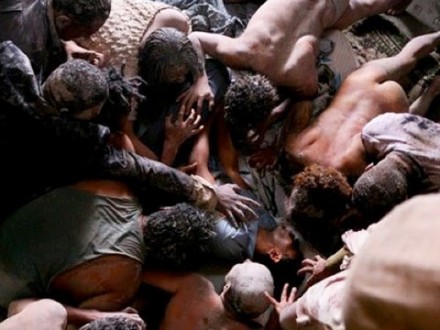
Ninjas
D.T. Trying to make links between your shorts and the feature. In Ninjas the main character is in bed, surrounded by these characters that represent his guilt, which is a bit like the end of The Nightshifter.
D.R. I never thought about that until now, but I love tragedies and I wanted The The Nightshifter to be a tragedy, just like Ninjas and Love from Mother Only were. It was difficult to convince the network of that. It works well as an opening to a possible series, but I had some convincing to do to let the network allow the bitter ending. But there’s a difference here from Ninjas. In the short film, Jailton is surrounded by his guilt but he is impervious to it. He sleeps the sleep of the just. Whereas Stênio carries his guilt and is tormented by it. He has to go into exile with it, followed by it. I think it’s two different ways of having characters handle their guilt, but they echo each other.
D.T. There’s another echo with your contribution to ABCs of Death 2, “J for Jesus,” when the gay character is being tortured by police, they take on demon masks and we’re never sure if these are literal masks donned by the police or if he is hallucinating them or if, perhaps, they turn into actual demons. It’s very ambiguous. And we have that in The Nightshifter as well, we’re not sure at some points if things are in Stênio’s imagination or not.
D.R. Yes it’s ambiguous, up to a point. Another SPOILER here, but by the end of the film he sees Odete, in the basement scene, and is convinced that she’s really there. The window explodes and she orders Stênio to go away, so Lara and the kids, although they can’t see her, are convinced that she’s there. From then on it’s no longer in Stênio’s mind. So I slowly bring Odete into the awareness of the other characters, starting with the girl when she’s attacked by the ghost of the mother in the stove scene. She’s the first one that is convinced, and by the end everyone is convinced.
R.J. The sound in all of your films is amazing. In Love from Mother Only you had this particular element where you have the record player going and the occult stuff starts happening when the needle is sitting at the end of the record looping in static and crackles. And later you have the static on the radio too. There’s a long history of these kinds of technological disruptions that connected to Spiritualism in the early 20th Century, where people thought they could hear the voices of the dead in radio static and that kind of thing. Is there something like this in Macumba, some connection between technology and the spirit world?
D.R. Not really. For me, when I was a kid I found this short wave radio and could listen to radio stations all over the world but the reception was really bad. One time when I was around nine years old, very late at night, I was able to tune this radio station from London and there was someone reading Crimes from Rue Morgue by Edgar Allan Poe. That creeped the hell out me so I kept this memory with me. So in Love from Mother Only the characters live in this isolated village of fisherman, and I wanted to make it a timeless piece, so we had all these religious radio shows playing in the background etc. It wasn’t about the idea of being in contact with the dead through them, just more of an atmosphere.
But there is one thing in the film that might connect to what you’re talking about. At the end of the film, I found these old recordings of Alistair Crowley reciting incantations on wax cylinders that were later transposed to CD format in an album called The Great Beast Speaks. So I used some of those incantations laced in between the radio broadcasts, so it’s not exactly like contacting the dead, but it is a bit like the devil speaking through the technology in this space.
R.J. Some of the sound in The Nightshifter is interesting, when the corpses are speaking, for example, the sound is treated differently, even pushing the voices through the full surround sound field. Did you make a conscious distinction between the voices of people who are alive and dead in the film?
D.R. Yes, there are two treatments. Whenever we get the dead folks’ POV, we also hear like them. So Stênio’s voice is distorted when he’s talking to the corpses and we hear through their ears. And then whenever there is an objective camera, and we see the dead speaking, their own voices are altered. The idea is that I wanted them to sound strenuous, to sound as if whatever small and vanishing life energy the body had was mobilized through the vocal chords and in the eyes, looking for Stênio and trying to talk to him. This horrible effort to draw the voice out, so that’s how it sounds. Hoarse and full of effort to come out.
R.J. It’s very well realized. And someone asked you in the Q+A about the visual treatment of the corpses, where the body is completely still except for the eyes and mouths. You started to tell us a bit about that process, working with a CGI company to achieve that instead of trying to achieve it entirely through the performance of the actors, which didn’t look convincingly dead on set.
D.R. I was lucky enough to know a few things before we started the shoot. One is that I was very well acquainted with the universe of the morgue and the The Nightshifter, years before the film. Years before even having the idea of the film I had been the production designer on two short films that were shot in morgues. Then there is a short film made by this celebrated director of commercials in Brazil, a very good film of mine, and in the early 90s he made this film called The Pulse, which is a love story that happens in a morgue. And he built the morgue for that film and had the actors playing dead. At a big Brazilian festival he was asked how it was directing big Brazilian actors to play dead. He said it was hell because they always end up breathing, blinking, etc. Signs of life would manifest. So with that in mind, I though that I had to design some way for the paralysis of death to be visible, for the corpses to look really lifeless. So after much discussion, and even trying rehearsals to have the actors playing dead as convincingly as possible – and I wasn’t convinced by that – we decided on a hybrid solution. We made realistic rubber dummies, cast from the bodies of the actors themselves, which would look absolutely lifeless, and then do face replacement in 3D animation. I was scared as to death to do that. I wasn’t happy with the first tests that we did, but the postproduction people said, “look, trust us, this will work. We’re going to work on that for a year, but we’re going to make it work.” And they did! It ruined my health waiting for it, but they did the trick in the end. I tried to be as objective as possible, watching the audiences, and I was very surprised at how effective it was. Everyone came up to me afterwards and told me it was really great because, when I saw the dead talking, I couldn’t understand what was wrong. There was something weird in there.
D.T. Was the image of the head in the jar done the same way?
D.R. Yeah. They made this fantastic looking dummy for her. We used it in the scene where he talks to the cadaver on the slab in the morgue, and we used it in the scene right before that and he sees a crime scene where she’s dead. It’s her dummy there, but it’s perfect looking. It’s her. It’s Fabiula. Then we chopped it’s head off after we shot those scenes, we put it inside an aquarium, filled it with water, shot the head, and then we shot the actress’ real head with tracking dots and used that to composite to the shot of the dummy head. That’s one scene in particular that I’m really proud of because it looks better than what was scripted. How I envisioned it, and the solution proposed by the post-production guys, they made it look beautiful.
D.T. Yeah there’s something along the lines of the uncanny there. You’re looking at something that looks both alive and dead at the same time. It works because you’re conscious of the effect, but it’s strange because there’s nothing else in the film with that same CGI effect. Freud talked about the uncanny, when we are very young, we have trouble distinguishing between animate and inanimate, like dolls, and when we grow up, these things that remind us of these initial fears it’s like the return of the repressed. So when we see something like your dead heads in the film, we return to these fears we had as kids. It’s dead, but it looks alive. Really creepy. It works.
D.R. I’m happy to hear that! Especially coming from you, such a seasoned viewer and scholar of horror film.
D.T. And the head in a jar seems also like a reference to Love from Mother Only with all the jars and the snakes around the Macumba ritual.
D.R. Yeah, the snakes. I don’t know if I’ve ever mentioned it, but that’s drinkable content, you know, the water from the snake jars. These snakes are sunk in fire water for cachaça [Brazilian alcoholic beverage]. People drink that. And the guy who brought the jars with the snakes in them, for the short film, he gave me a small jar with a baby snake in it. I have it to this day and always show my kids. Look, it’s a real snake!
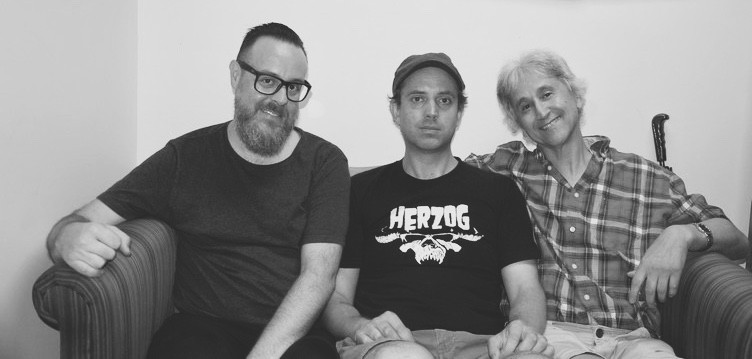
Dennison Ramalho, Randolph Jordan, and Donato Totaro (July 24th, 2018)

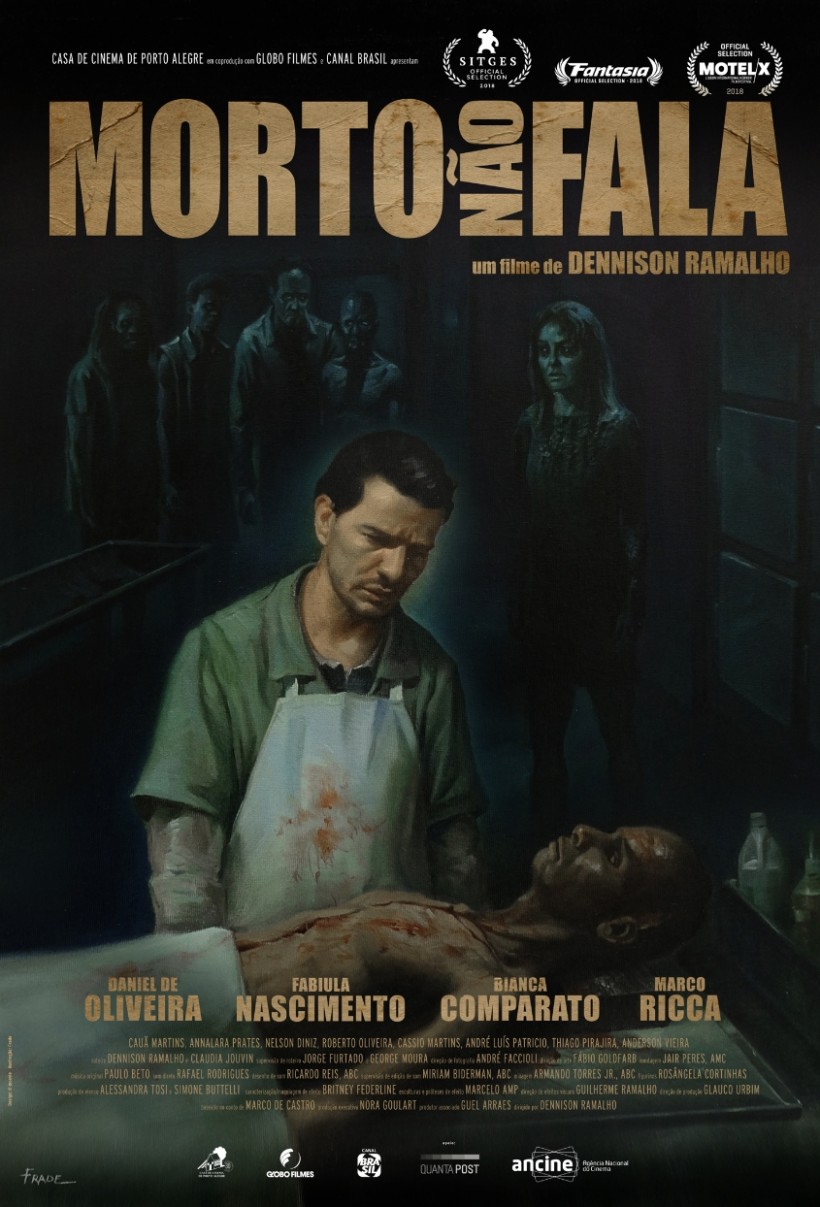
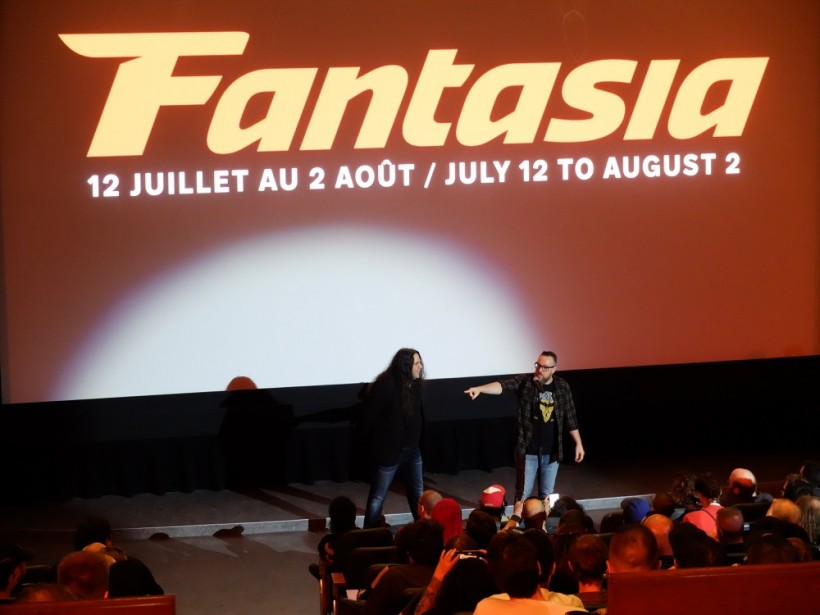
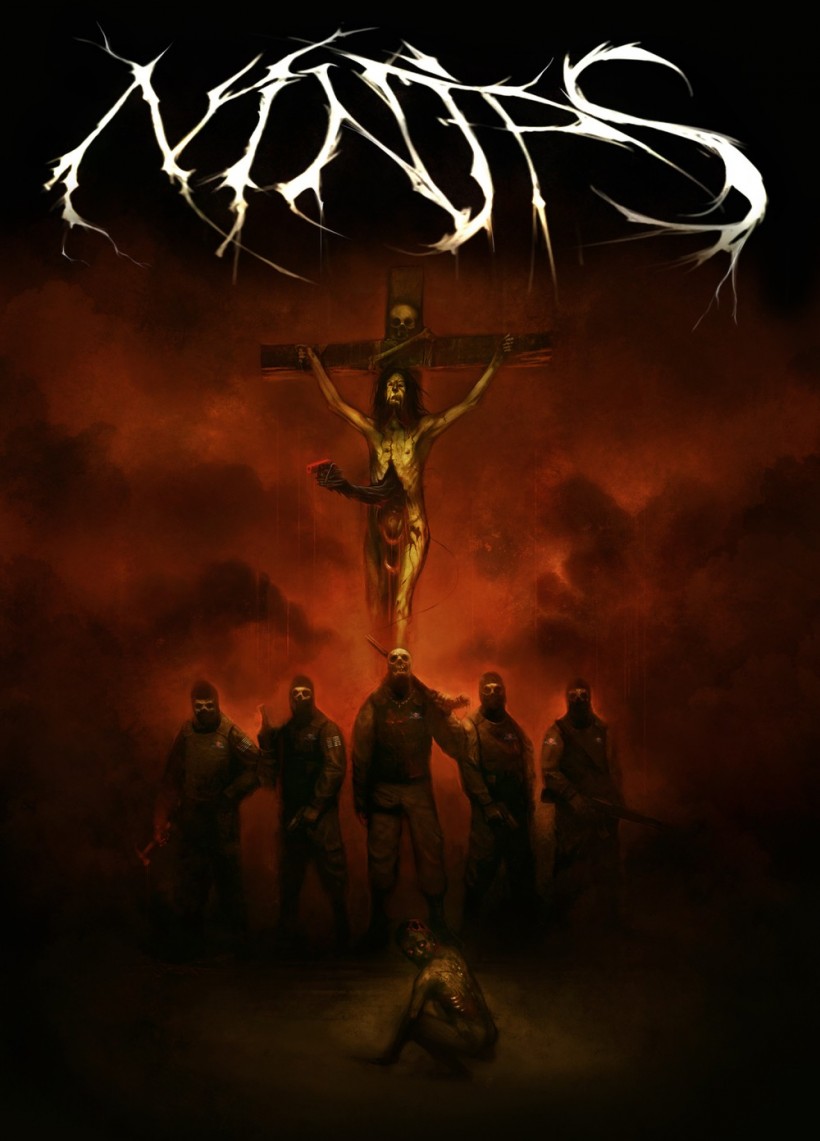
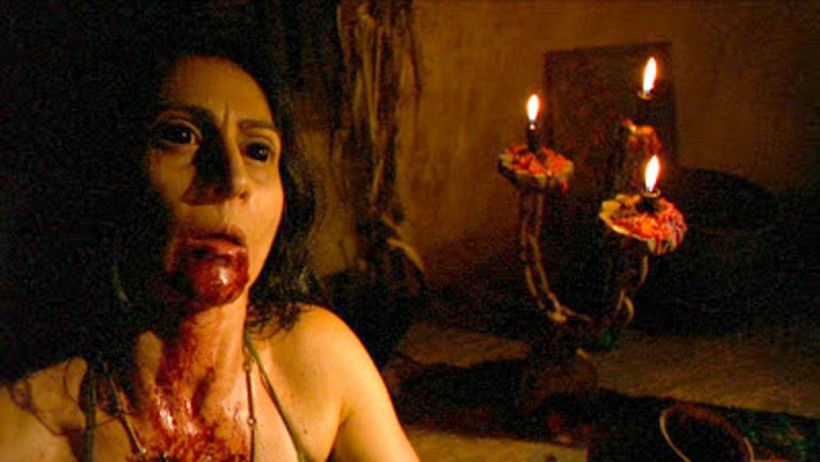
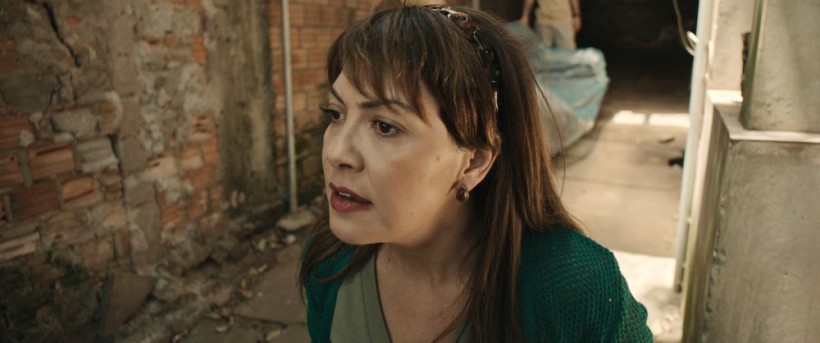
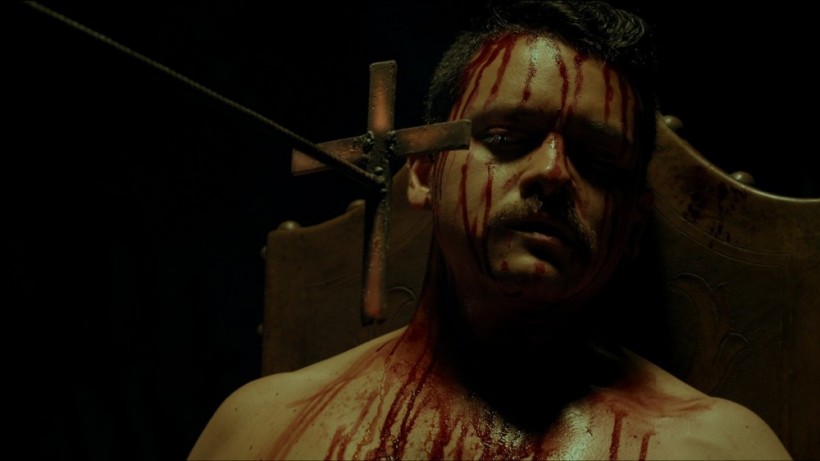
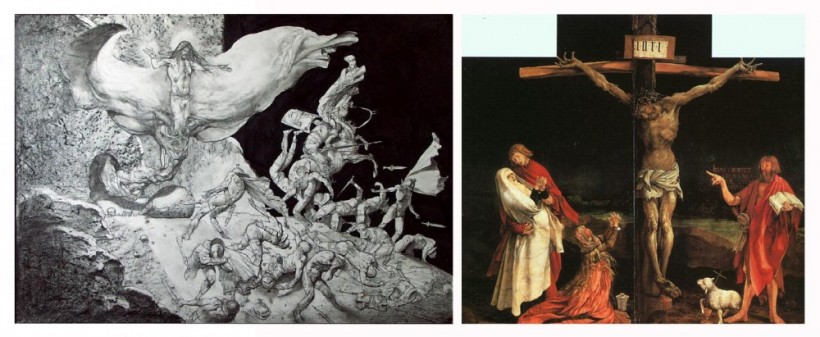
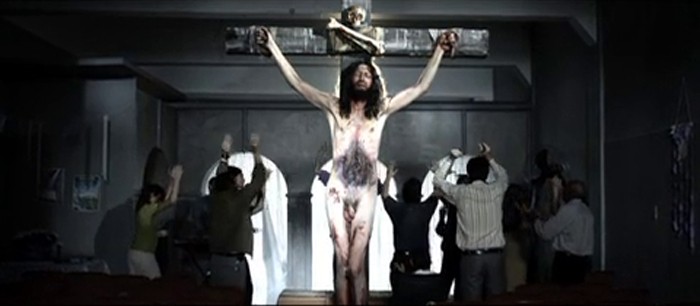
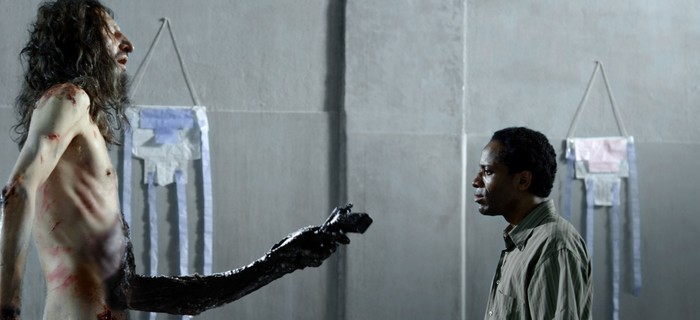
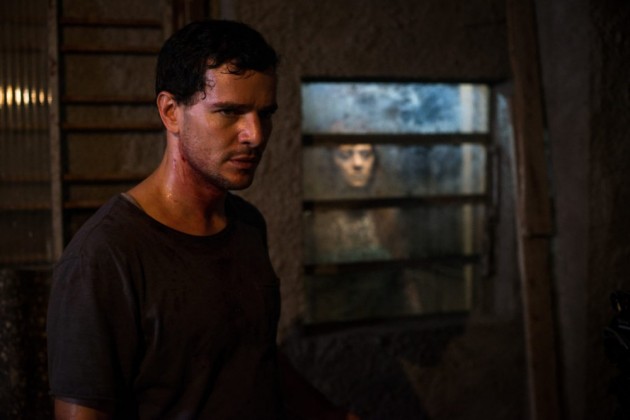
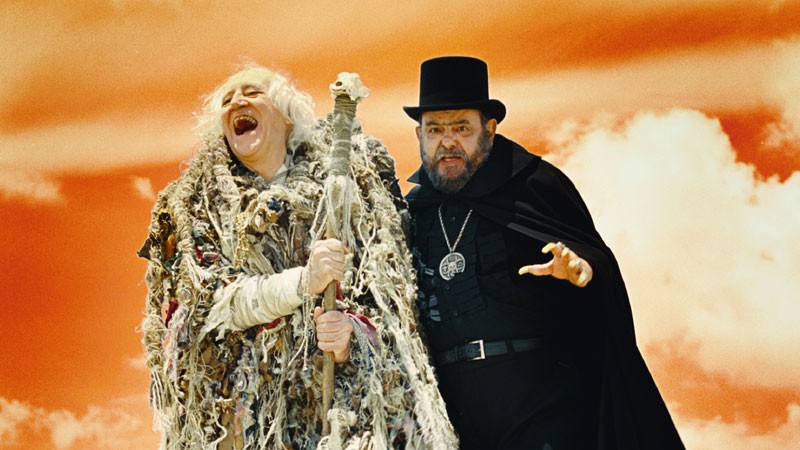
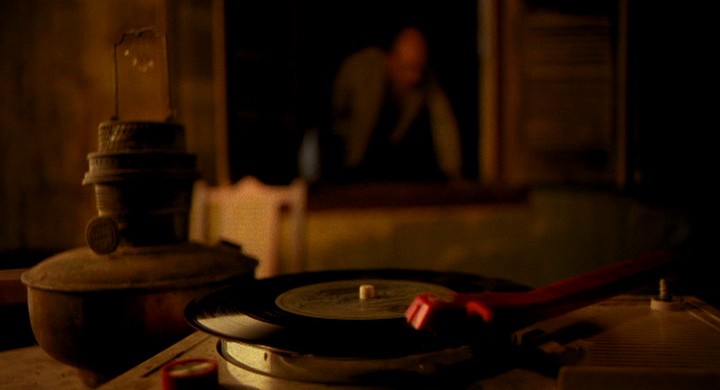
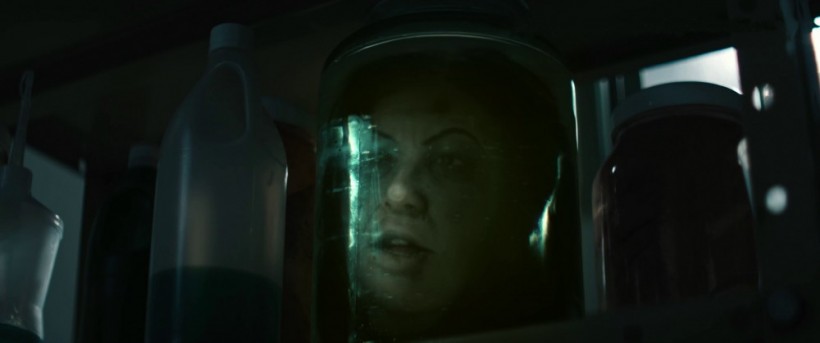



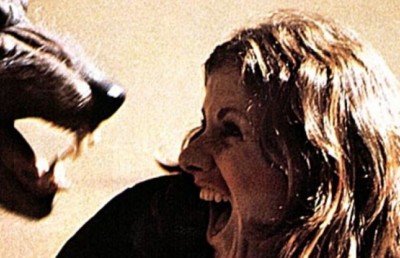


_400_258_90_s_c1.jpg)







